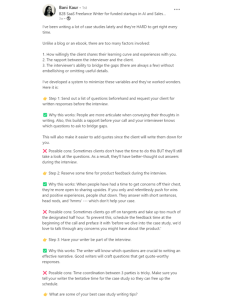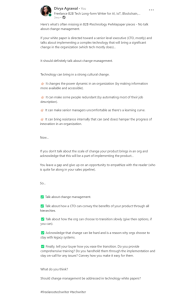Feeling ‘meh’ about posting on LinkedIn lately? Sooner or later we may find ourselves unenthused when it comes to marketing our services. But a regular marketing habit benefits our business, protecting it from the feast-or-famine cycle when work dries up slowly or suddenly.
Consistent marketing helps maintain a healthy pipeline of leads that we can tap into when we want to increase our rates or drop a client.
It’s normal not to feel creative and motivated to post content on LinkedIn occasionally. However, if it’s a key marketing strategy for you, you may want to overcome the block sooner rather than later. So, let’s help you put yourself out there for ideal clients to know and trust your expertise.
Get inspired by these five impactful posts from incredible writers. Study each post’s format and flow and get inspired to write your own content that helps you stand out and show your credibility. (A note of warning: Some of their language or ideas may not be for everyone, but it does clearly show their persona to the reader.)
Example #1 — Share Your Writing Process from Your Unique Perspective
This post by Bani Kaur is a manifestation of “show don’t tell.” It reveals the writer’s case study writing process and their understanding of the nuances involved in the work. This kind of content is a more subtle way of demonstrating your expertise and experience.
Here’s how you can create your own post using this example:
- Talk about a challenging experience you frequently/currently come across. “I’ve been writing a lot of case studies lately. And they’re hard to get right every time.”
- Tell us WHY the challenge exists. Expand on it. What constitutes the struggle to accomplish this particular action, such as writing a case study?
- Write down the steps you take to go from the start to the end point of the process. Don’t worry about filling in the details just yet.
- For each step, mention why it works and how it addresses the challenge. Enrich the content by adding caveats to the success of this step. What should be in place to make this step a success? In what case can the action step be hard to achieve?

Example #2 — Share Your Industry Knowledge with Powerful How-Tos
“How-to” LinkedIn posts may not be everyone’s style as they are authoritative and explicit. This one from Olena Bomko packs a punch. In a slide with 15 examples, the writer talks about several ways case studies can be used as social proof on a website. This is valuable information for the writer’s target audience. And, they’ll be convinced of the writer’s credibility and experience by the end of it.
When you tell someone how to do something, they automatically assume you know how to do it. Here’s how to create your own how-to post (this just got meta!):
- Identify a subject you have the authority to speak about. This can be a narrow or broad topic you’ve been practicing for years. For instance, “how to create blog posts that rank on the first page of search engine results” or “how to write customer-first case studies” or “how to create the perfect pitch for your dream magazine.”
- Decide if this content would be more effective presented visually or textually.
- Then, supplement it with examples, statistics, and illustrations to help your target audience achieve what you promised to show them in the title of the content.
When your ideal clients read this post, they’ll get invaluable insights backed by reliable data and enriched with examples that show exactly how to accomplish the task. Some may go ahead and do it themselves. But they aren’t your ideal clients anyway.

Example #3 — Consolidate Your Experience into Useful Information
As a freelance writer, you have accumulated experience working with clients, coaching other freelance writers, or upskilling yourself. For instance, you might know the common mistakes clients make when editing blog content. Or, you might know what editors are looking for after having worked with many editors over the years. You may have helped many clients improve their blog traffic and know what goes into it.
You can consolidate your experience in a rich and valuable LinkedIn post, just like Tommy Walker does here.
- Start by telling WHY your readers should trust your insight on this topic. Establish your authority. “Over the last 10 years, I’ve edited hundreds of articles from dozens of freelance writers.”
- Then, go into your experience and merge your insights, lessons, mistakes, or feedback.
- Expand on each idea. Tell us why it matters and how the reader can take the information and act on it.
You’ll have a LinkedIn post that shows your experience and expertise and distills it into something actionable for your ideal client.

Example #4 — Share an Opinion or Keen Insight
You arrive at realizations and opinions about your industry/work as you progress in your career. What are some opinions you hold about working with clients, writing, or the marketing industry? In this post, I shared an opinion about how change management is often mistakenly missing from white paper content.
Here’s how to get inspired by this example and create your own version:
- Brainstorm opinions and perspectives you hold about your industry. See what others post about and introspect your own thoughts about it. Are they different from others?
- Pick one idea and expand on why your perspective makes sense. What makes you think/believe what you do?
- What happens if you miss out on this way of thinking/doing? What happens or doesn’t happen?
- Detail how readers can incorporate this idea into their work.
Sharing a strong opinion or a nuanced insight about how something is done in your industry shows you’ve been around for some time to form a distinct opinion.

Example #5 — Dismantle Your Ideal Client’s Myths and Reservations
Jason Vana dismantles the myth that “a content agency can’t write for your personal brand” in this post. It’s an impactful post with proof of why this thinking is limited and the notion flawed.
Here’s how to use this example to write your LinkedIn post:
- Make a list of the myths or reservations clients have about your services.
- Pick one and challenge it using examples where you’ve proven it wrong. Provide as much information and results as possible. Make a strong case.
- Show how you provide the service to achieve the client’s goals and prove the myth wrong.
Your clients may have many questions and doubts while engaging your freelance writing services. Posts that dismantle their reservations and myths can strengthen their trust in you. This content also shows how empathetic and understanding you are of your clients.

Use these examples to create your next set of LinkedIn posts and continue marketing your services with impactful messaging.